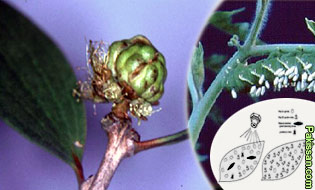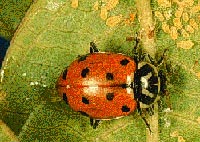|
Biological control of
natural enemies
By Bhai Khan
Solangi
In Sindh and other provinces of Pakistan, farmers spray toxic
chemicals (pesticides) on cotton, vegetables, oilseeds and
fruit crops. The pesticides have brought positive results in
boosting production but many chemicals have caused resistance
in pest species.
 Its intensive and indiscriminate use has caused diseases such
as cardiac, diabetics, indigestion, and kidney failure etc. It
has also resulted in the environmental pollution, besides,
contaminating food. Its intensive and indiscriminate use has caused diseases such
as cardiac, diabetics, indigestion, and kidney failure etc. It
has also resulted in the environmental pollution, besides,
contaminating food.
Pesticides have been accumulating in the soil, air and water
which calls for safe and cheap control methods. This can only
be achieved through the Integrated Pest Management (IPM)
practice.
Pest control through environmentally safe ways is considered
an integral part of balanced agro ecosystem management and
protection. An effective management requires monitoring of
insect population and observance of scientifically-based
threshold values.
Pesticides use is one of the most common and effective methods
for controlling pests and plant diseases. One of the safest
biological methods is through predators and parasites.
All insect populations are affected to a greater or lesser
extent by natural enemies, meaning the "balance of nature" and
natural regulation. Actually, Darwin's term "struggle for
existence" is what we call natural enemies. These are the
primary regulating force in the dynamics of their populations.
It is important to know what natural enemies are affecting an
insect pest population and to obtain an estimate of their
impact. Such information may be the basis for explaining pest
population density and predicting outbreaks.
Since the establishment of canal system in Sindh, many
important crops are cultivated round the year. Due to regular
cultivation of land, hundreds of insect pests appear that
reduce the quality and quantity of crops.
Development of the predator population depends on the
availability of prey. A number of beneficial insects are found
in fields, where their food habits are different. A high
reproductive rate is important so that populations of natural
enemy can rapidly increase when hosts are available.
In Pakistan some experiments have proved that many insect
predators naturally occur on the agro-ecosystem and feed on
different pests. Amongst those predators, Coccinellid beetles
occupy a unique position as a biological controlling agent.
Ladybird beetles belong to the family Coccinellidae, order
Coleoptera class insecta. The Coleoptera comprises largest
group of insects. These vary in size from 0.25mm to 150mm. The
wing structure is quite characteristic. The front pair of
wings are known as elytra.
 Elytra are hard and thick sheath serving as a cover for their
body and hind membranous wings. Hind wings are used for flight
and during flight the front elytra are kept stretched on each
side. The Coleoptera is the largest order in class insecta
having 220,000 described species. Elytra are hard and thick sheath serving as a cover for their
body and hind membranous wings. Hind wings are used for flight
and during flight the front elytra are kept stretched on each
side. The Coleoptera is the largest order in class insecta
having 220,000 described species.
The Ladybird beetles are widely distributed throughout the
world and feed on many insect species which occur on trees,
shrubs, weeds, grasses and cultivated crops. Therefore,
Ladybird beetles are known as one of the most beneficial and
recognizable groups of insects.
The bright colours of Ladybird beetles warn enemies that they
have a bitter taste. The spots of each species are arranged in
a different pattern. They are carnivorous characterized by the
mandibles having simple or bifid apices and each jaw being
armed with a basal tooth for grasping and chewing their hosts.
The common species of Ladybird beetles, which occur in our
agro-ecosystem are; 7-spotted beetle, coccinella
septempunctata L., 11-spotted beetle, Coccinella
undecumpunctata L., Zigzag beetle, Menochilus sexmaculatus
Fab., Coccinella transversals and Brumus suturalis F. These
are most important of all predators, both adults and larvae
are voracious predators of many insect species.
Scientifically, it has been proved that the above mentioned
beetles, each can consume about 40-60 individuals/day of
aphids, jassids, white flies, mites, scale insect and eggs of
various moths.
Looking at the efficiency of Ladybird beetles, we have to
promote these insect species to control the noxious pests and
to avoid the use of pesticides, which will keep our
environment safe and healthy.
Courtesy:The
DAWN |
Pakissan.com;
|